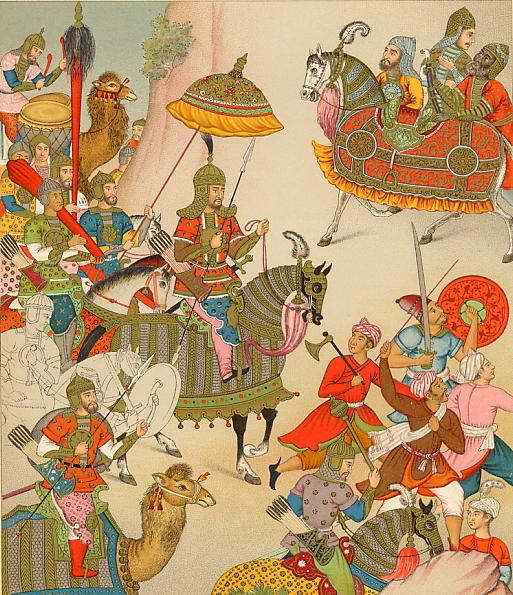

Racinet's view of Babur setting out with his army (1876); *a larger scan*
Source: ebay, Jan. 2002
"Color Lithograph from 1876. Military Costumes of India - 16th Century. Legend: 'These fragments are taken from a 16th C. painting representing Djahir - El-din Mohammed, Bâber nicknamed (the Tiger), the king and emperor of India, leaving at the head of his army to invade the province of Mazindera, in Persia. He was the Indian emperor (1526-30) and founder of the Mughal dynasty of India, a descendant of the Mongol conqueror Genghis Khan and also of Timur (Tamerlane). He was a military adventurer and soldier of distinction and a poet and diarist of genius, as well as a statesman. Babur is rightly considered the founder of the Indian Mughal Empire, even though the work of consolidating the empire was performed by his grandson Akbar. Babur, moreover, provided the glamour of magnetic leadership that inspired the next two generations. Babur was a military adventurer of genius, an empire builder of good fortune, and an engaging personality. He was also a Turkey poet of considerable gifts that would have won him distinction apart from his political career. He was a lover of nature who constructed gardens wherever he went and complemented beautiful spots by holding convivial parties. Finally, his prose memoirs, the Babur-nameh, have become a world classic of autobiography. They were translated from Turki into Persian in Akbar's reign (1589) and were translated into English in two volumes in 1921-22 with the title Memoirs of Babur. They portray a ruler unusually magnanimous for his age, cultured, witty, convivial, and full of good fellowship and adventurous spirit, with a sensitive eye for natural beauty.
In this print, the Mogul is represented with all the attributes of the ruler, especially the parasol, carried over him. He is wearing a silk jacket, short sleeved, and a round shaped skirt, with ornamental design and large metal button-plate on his chest. The jacked is padded to protect against the arrows and his knees are also protected by metal plates. In his right hand, he is holding one of the offensive weapons of the time, a spear, with ends being finished with decorated metal, on the left side he wears a saber and on his belt, a quiver with feather arrows is attached. The soldier behind him carries a hammer like weapon, which could also be a heavy wood club, he is holding it with both his hands, indicating the heaviness of the weapon. The mogul's horse is entirely protected with armor of overlapped blades. An interesting feature is that he does not were the rider's boots but his personal slippers. Another interesting feature of this painting is the lack of elephants in his army. Before the ruler, we see a number of infantrymen who proceed him and by shouting create a necessary room for him to pass."
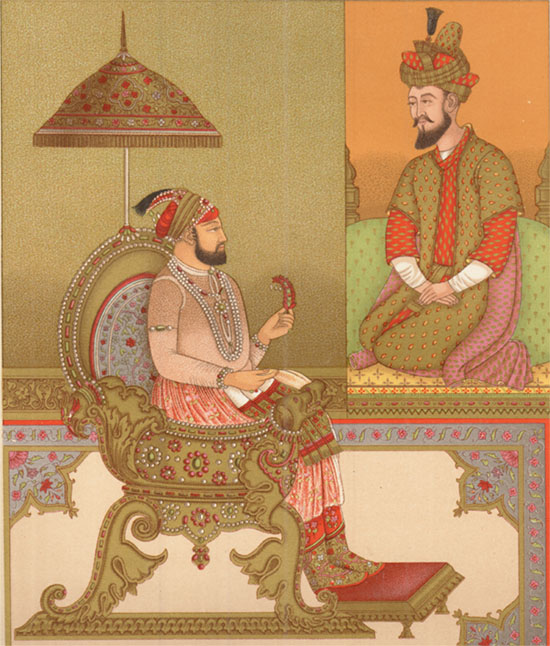
Another chromolithograph in the Racinet series: Humayun and Babur
Source: ebay, Mar. 2002
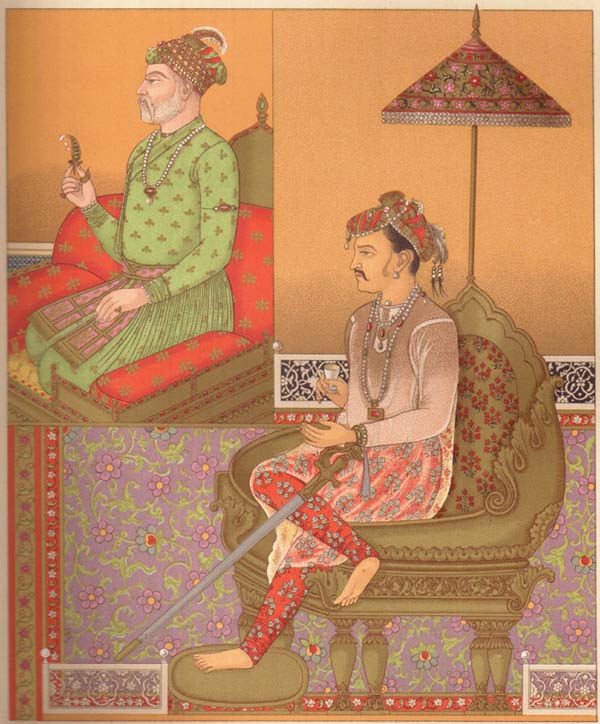
Akbar and Jahangir by Racinet, Paris 1801
Source: ebay, Feb. 2002
"Chromolithograph of Mogul Emperor Akbar and Jahangir, Lithographed by Chataignon, Imp. Firmin Didot Cie, Paris, 1801A.D on white heavy paper. Size:12.5X15.0 cms. The illustration is from a series of volumes by Albert Racinet, first published between 1801 and 1805. The twelve-volume series showed all forms of human dresses and costumes habits across the world. It won prizes in 1806 and at the London Universal Exhibition 1851 was judged the most perfect typographical production of all countries and all times."

Racinet 1876: another version of Akbar and Jahangir
Source: ebay, Nov. 2005
"THE MOGUL EMPIRE WAS FOUNDED IN 1505, but Aureng-Zeb was the
Emperor
responsible for its geographical expansion: he had acquired some 64
million
subjects before his death in 1707 at the age of 88. The Court of the
Grand
Mogul - as the Mogul emperors were known - was one of the richest
imagineable,
drawing as it could on all the riches of Hindustan. 1. The
Emperor
Djehanguir, who ruled from 1605 to his death in 1627, sitting on his
throne
beneath a parasol. The apparent simplicity of his costume is most
elegant:
he has a most attractive pearl and diamond turban, and his delicate
robe
is made from fine cotton from the Dacca region.
The
golden throne, silk rug and silver railings are all
traditional,
though one would have expected the Emperor to have been wearing
rings
on his fingers. Inset, with a spray of feathers, is
another
Emperor, Djehander-Schah, who was crowned in 1712, but beheaded a
month later. 2 & 3 Mogul women, wearing veils of thin muslin, with
jewels on their foreheads, ears and hands. Their robes are made of fine
cotton from Dacca, and their trousers, of embroidered silk, come from
the
valley of Kashmir. Their breasts are supported by cases made from a
very
light, flexible wood, joined together in the middle and strapped on
behind.
After washing, Mogul women apply sandalwood powder as a perfume, then
highlight
their eyes with antimony. They paint their nails a vermilion colour,
using
the sap of the maldroni plant."

Farrukhsiyar and Babur
Source: ebay, Oct. 2005
"Costume of India - Moguls. Author and Artist: Albert Racinet.
Legend:
[upper left corner] A Mogul woman who has colored her upper body and
face yellow with saffron dye.
[center] The Mogul Emperor Farouksiar, who died in 1719, and
the Emperor Houmaioun [upper right corner], who died in
1556.
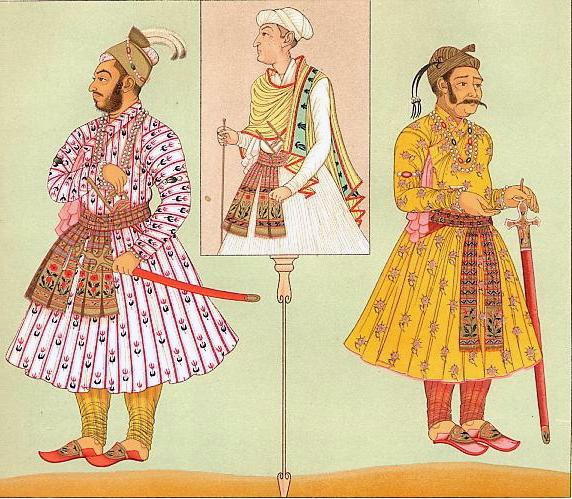
Murad Bakhsh by Racinet (1878 ed.)
Source: ebay, Oct. 2005
"Legend: Fig. 1. Mourad Bakche, imperial prince, son of Shah Djehan and brother of Aureng Zeb; 2. Indian prince from the 17th Century; 3. Delhi sovereign. This emperor, whose name is us unknown, seem to have been rather a speaker that a man of action; he evidently discourses. His turban is of gold fabric decorated of a plume falling down under the weight of two diamonds. He wears a necklace with double row of pearls comprised of ruby and emeralds; he wears bracelets on his wirsts and even on the top of the right arm. The yellow tunic embellished with flowers is tightened in by a rich belt of cashmere. This ruler leans on a kounda, sharp saber of which the pommel and the hand are embellished with cloisonné enamel. Slippers also have their raised tips."
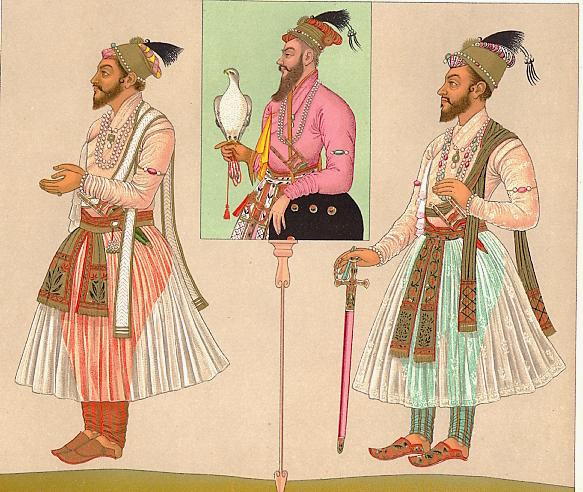
Two miscellaneous "Mogul emperors," and Shah Alam (1876 ed.)
Source: ebay, Oct. 2005
"Costumes of India. Author and Artist: Albert Racinet. Legend: The larger figures on the sides are Mogul emperors, wearing identical clothes. A cloth turban ends in a point over the forehead; and a golden band set with pearls and precious stones surmounts it. At the turban's crown a jewel representing the sun supports a spray of feathers - a royal symbol. In the center is Shah Alem with a kounda, straight saber, in a sheath covered with velvet."
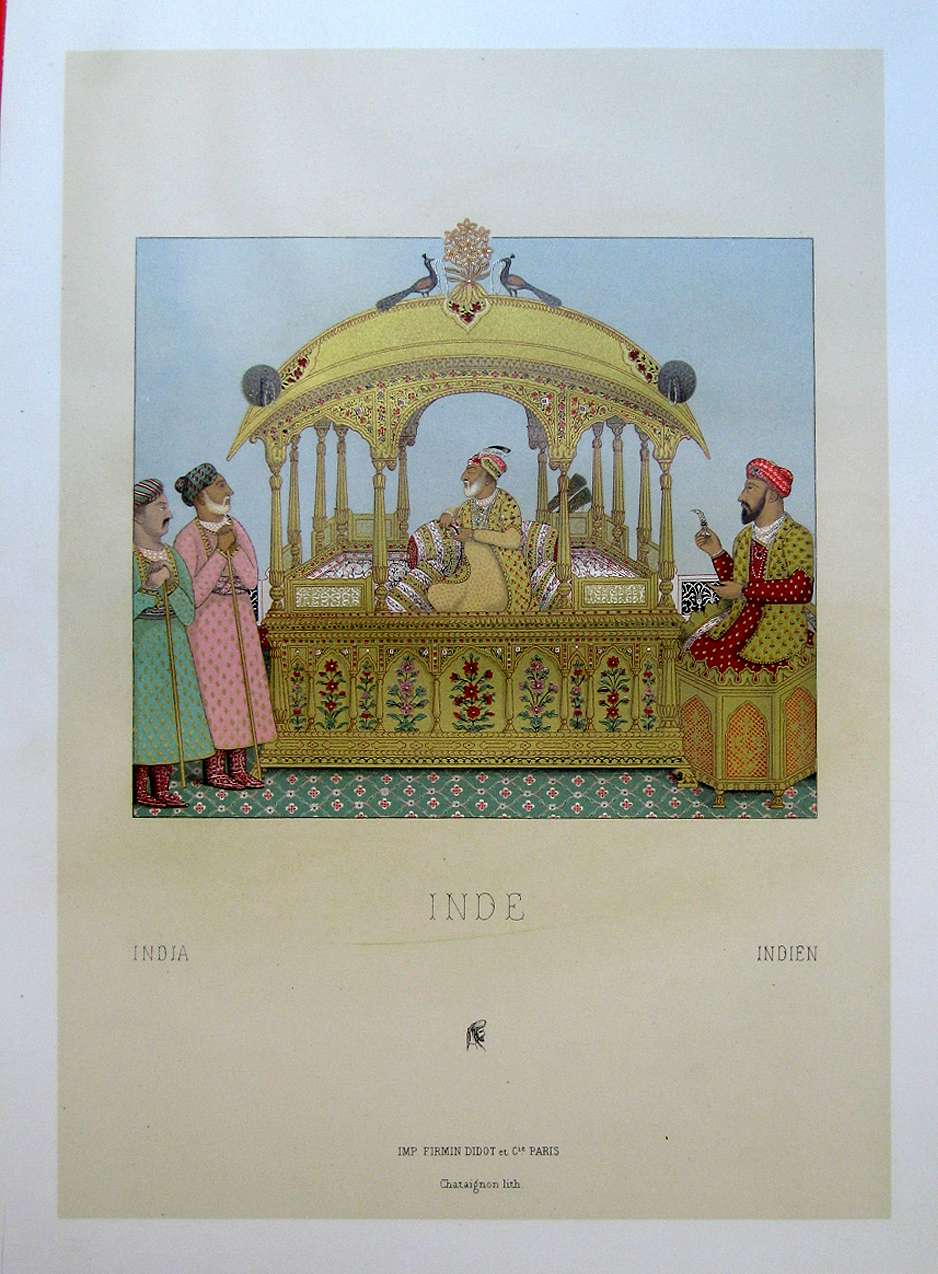
From Racinet, 1876: "Moguls of India"
Source: ebay, Nov. 2005
"This reproduction of an Indian miniature represents a Grand Mogul sitting on a throne. The miniature dates from the 17th century. These thrones were of elaborate ornamentation and raised admiration wherever they appeared. The main motif of the ornamentation here is a peacock. Similar elaborate thrones were mounted on horses and elephants. Two persons on the left represent the officials of the royal court. It is not clear, what was the function of the person sitting on the hexagonal chair, most likely it was Himad-oud-Deulet, the prime minister."
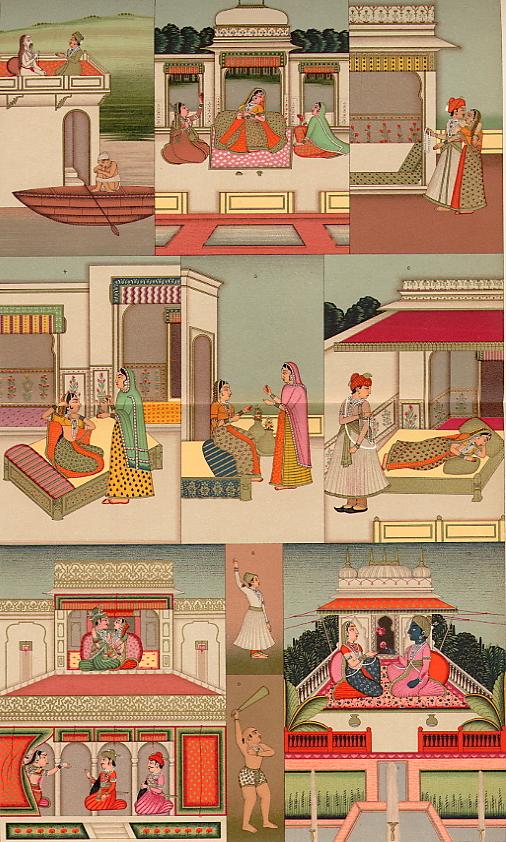
Racinet 1876: Mughal interiors
Source: ebay, Nov. 2005
"Interior of a house - Terraces. Palace of a mogul emperor - An emperor's favorite. Gymnosophist - Gymnasiarch. Figs. 2,3,4,5,7 and 10 (indicated in the print) depict the terraces of a 'malh' of Djehanguir from the first half of the 17th century. This emperor, who had his principal residence at Lahore, built a gorgeous palace in Cachmere. Its vegetation and architecture united in, what was called paradise on earth. Fig. 6 Represents a nuptial room where Sher Afkan is taking away a pearl necklace, the symbol of yoke. Fig. 1 shows a conversation between Djehanguir and one fakir, 8. Shows a dancing dervish, 9. A gymnasiarch, dressed in under shorts, ready for a fight or various exercises."
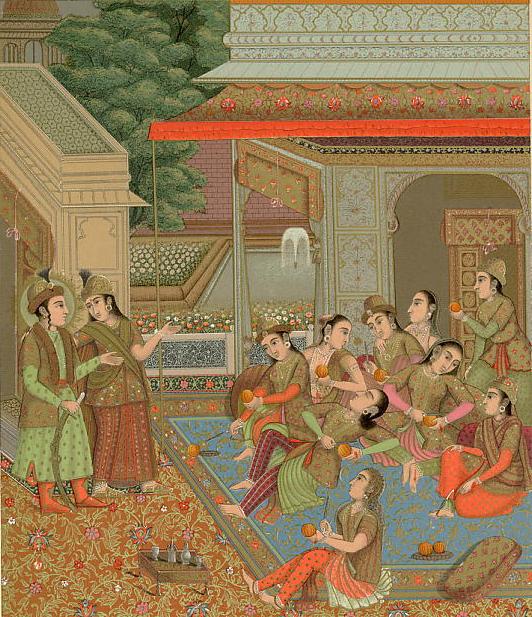
The story of Yusuf and Zulaikha, according to Racinet (1876 ed.); *a very large scan of this engraving (1888 edition)*
Source: ebay, Nov. 2005
"A facsimile of a painting representing Joseph and Zuléïka, the woman of Putiphar, which, having spoken to the women of her house of the vivid beauty of Joseph, presents him so that they can judge by themselves. These women, occupied by peeling the oranges, are struck by the beauty of the young man; one of them even dropped her peeling knife. This scene is one of the favorite topics of the Indian painters, which they often treat in their works of art. (The original of this miniature is part of the library of M. Ambroise Firmin-Didot.)."
== Indian Routes index == Indian Routes sitemap == Glossary == FWP's main page ==